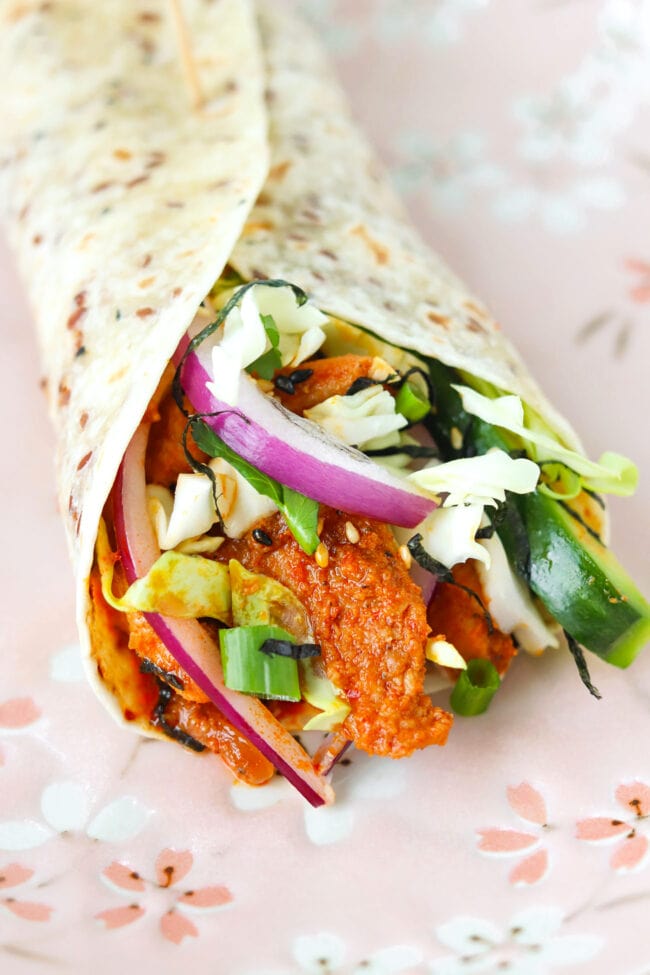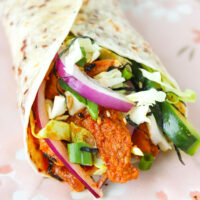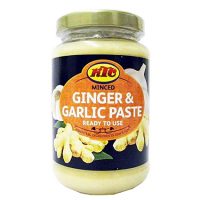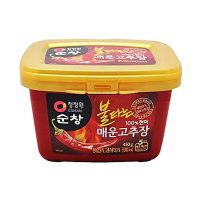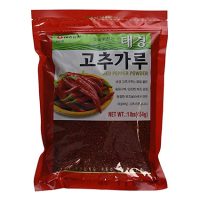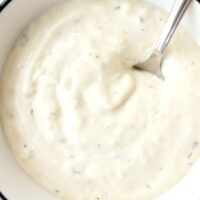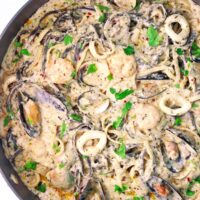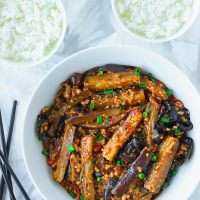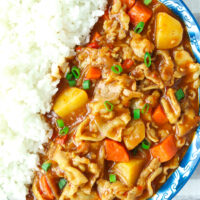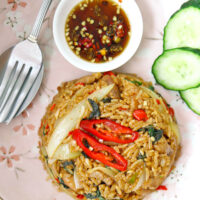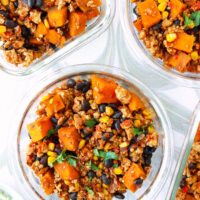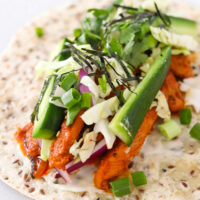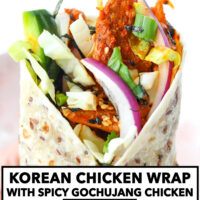Korean Chicken Wrap
This post contains affiliate links.
This Korean Chicken Wrap is easy to make, great for meal prep and easy lunches, and jam-packed with flavor! Spicy gochujang chicken strips are piled onto a tortilla and complimented with mayo, shredded cabbage, red onion, cucumber, coriander, spring onion, shredded seaweed and toasted sesame seeds!
Easy lunches with BIG flavors are my favorite, and this Korean Chicken Wrap ticks all the right boxes!
The star of these Korean-inspired tortilla wraps that was inspired by Pret’s version is the spicy gochujang chicken. We have juicy and tender chicken strips that are infused with the irresistible spicy-sweet and smoky flavors of gochujang (a Korean hot pepper paste), ginger garlic paste, and few Asian seasonings and sauces.
All you need to do is marinate the chicken, sauté in a pan, then pile onto tortillas along with some cooling mayo, shredded cabbage, red onion, cucumber, coriander, spring onion. Sprinkle on some shredded seaweed and toasted white and black sesame seeds. Then fold and devour!
Then repeat three or four times this week because hey-ho, these low-effort wraps are great for meal prep and easy lunches!
If you’re counting carbs or simply want to have a lighter lunch, pile the spicy gochujang chicken and toppings onto butter or bibb lettuce leaves to make spicy Korean chicken lettuce wraps instead. I can also vouch that the chicken tastes DELICIOUS with steamed rice. Make a full meal out of it and serve the veggie toppings on the side as a salad.
Why This Recipe Works
- Quick and easy! There’s under 10 minutes of active cooking involved and most of the time is letting the marinade do its magic on the chicken. Assembling the wraps are a breeze too.
- AMAZING flavors and textures! The tender chicken strips in these wraps are full of spicy-sweet and smoky flavors courtesy of gochujang and other seasonings. Paired with cooling mayo and crunchy and crisp salad veggies in soft tortillas, the flavors and contrasting textures complement each other well.
- Tastes good hot or cold. You can enjoy the chicken hot or cold in the wrap – it’s delicious either way!
- Great for meal prep. The spicy gochujang chicken will keep for a couple of days in the fridge. Use it to make easy Korean chicken wraps for lunch during the week!
Ingredient Notes and Substitutes
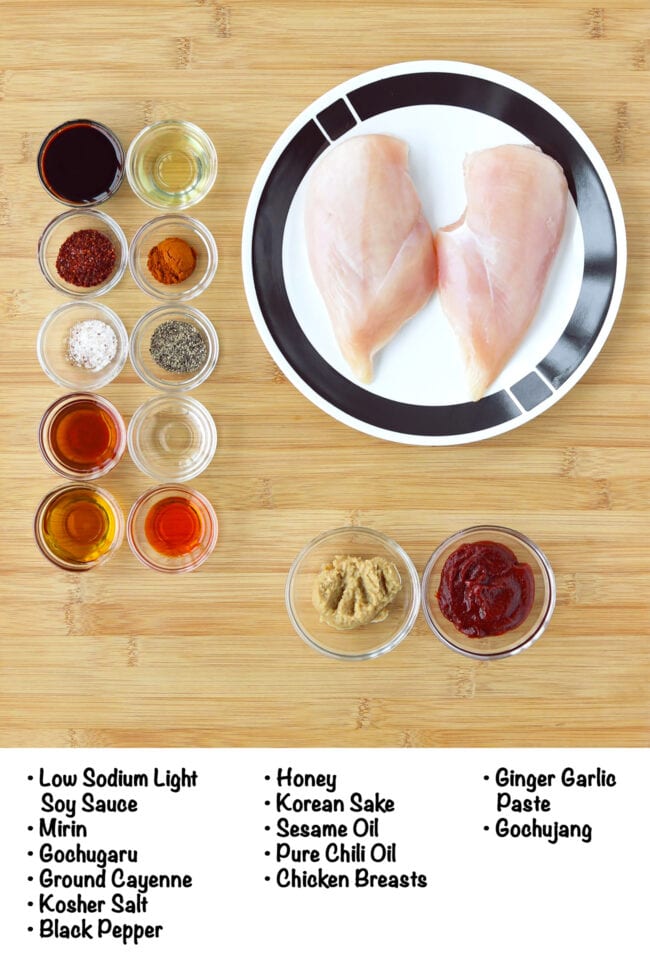
- Chicken Breasts: I’ve used boneless and skinless chicken breasts and cut them up into strips. You’re welcome to use boneless and skinless chicken thighs if you prefer.
- Gochujang: A fermented Korean chili pepper paste that is deep dark red in color, but not super spicy. It has a smoky and spicy-sweet flavor profile and tastes delicious in kimchi fried rice, kimchi chicken noodles stir-fry, spicy gochujang chicken meatballs, and also in the sauce used for dipping Korean fried chicken. It’s available in the Asian aisle of most mainstream supermarkets and in Korean and Asian supermarkets.
- Ginger Garlic Paste: A paste that’s commonly used in Indian cooking instead of fresh garlic and ginger. I’m a fan of using it in Korean marinade like the one for my spicy Korean pork stir-fry because it has a nice and smooth texture. Find it in an Indian grocery store or purchase a jar online. You’re welcome to substitute with finely minced or smashed fresh garlic and ginger instead.
- Low Sodium Light Soy Sauce: To season the chicken with savory umami notes, but we’re using low sodium in order to control the salt level better.
- Mirin: A Japanese sweet rice wine that is often used as a sweetener in Japanese cuisine. Korean cuisine has a counterpart, mirim, which is identical in flavor and taste. Look for it in an Asian supermarket. If you prefer not to cook with alcohol, add more honey instead.
- Gochugaru: A course ground Korean chili powder. It’s available in Korean grocery stores and Asian supermarkets. You might also be able to find it in the Asian aisle of some mainstream supermarkets that are well-stocked with international ingredients. Gochugaru comes in varying heat levels depending on the brand so adjust the quantity to taste. Substitute with chili powder if unavailable.
- Kosher Salt: Use slightly less than half the amount indicated if using iodized sea salt.
- Ground Cayenne (optional): For an extra kick of heat! Feel free to omit or use less if you’d like to make the chicken milder. You could also use chili powder in its place.
- Honey: To add a hint of sweetness to the chicken and balance out the spicy flavors. The honey also helps caramelize the exterior of the chicken strips when sautéing them.
- Korean Sake (optional): A Korean cooking wine used to help tenderize and bring out the flavors in the meat. You can use Japanese sake instead too. If you rather not cook with alcohol, leave it out.
- Sesame Oil: To infuse the chicken with fragrant toasted sesame aromas and flavors!
- Pure Chili Oil (optional): I used a chili oil without any seeds or flakes to add extra heat. You can use less or omit to make the chicken milder.
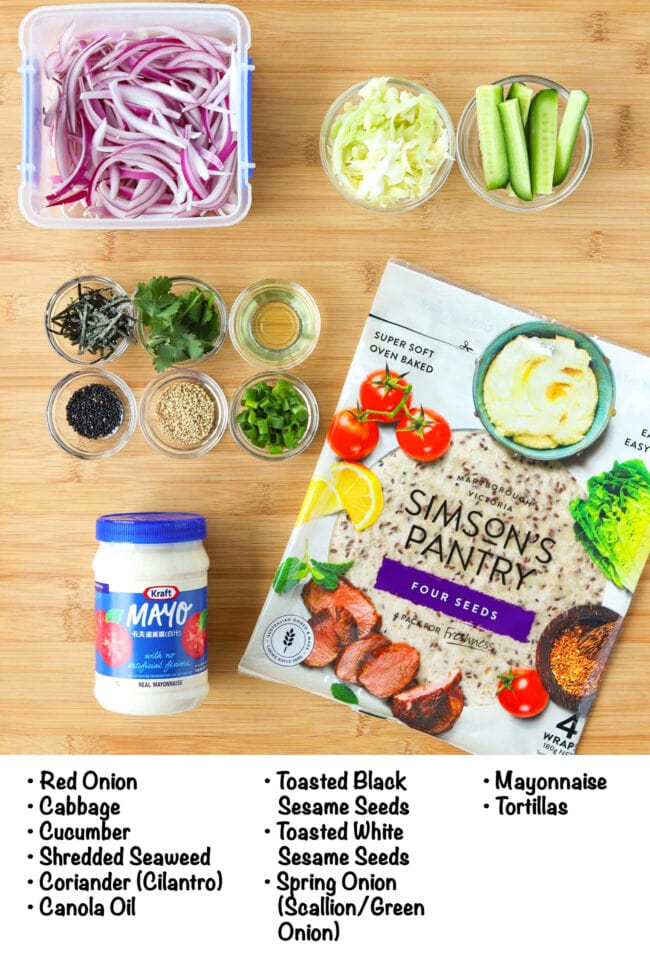
- Canola Oil: Feel free to use any other neutral flavored cooking oil.
- Red Onion: Or you can use yellow or white onion if you prefer. We’ll be sautéing some with the chicken in the pan and also using some raw slices in the Korean chicken wraps.
- Tortillas: I used four seeds tortillas, but feel free to use any tortilla you like such as plain flour, herbs, whole wheat, etc.
- Mayonnaise: Regular or low-fat.
- Cabbage: Either green or red will work.
- Cucumber: To add a refreshing and cooling flavor to compliment the spicy gochujang chicken.
- Coriander (Cilantro): Leave it out if you’re not a fan.
- Finely shredded Roasted Seaweed: I used store-bought shredded roasted seaweed, which is called ‘kizami nori‘ in Japanese. You can find it in packets at Japanese and Asian supermarkets. It have a savory umami flavor and crisp texture and is commonly used to top rice, noodles, vegetables, and meat and seafood bowls in Japanese cuisine. Feel free to leave it out if you don’t have it on hand.
- Toasted White and Black Sesame Seeds: For sprinkling at the end. You can use store-bought or toast the raw seeds in a pan over medium-low heat until fragrant.
Full ingredient list and amounts are in the recipe card below.
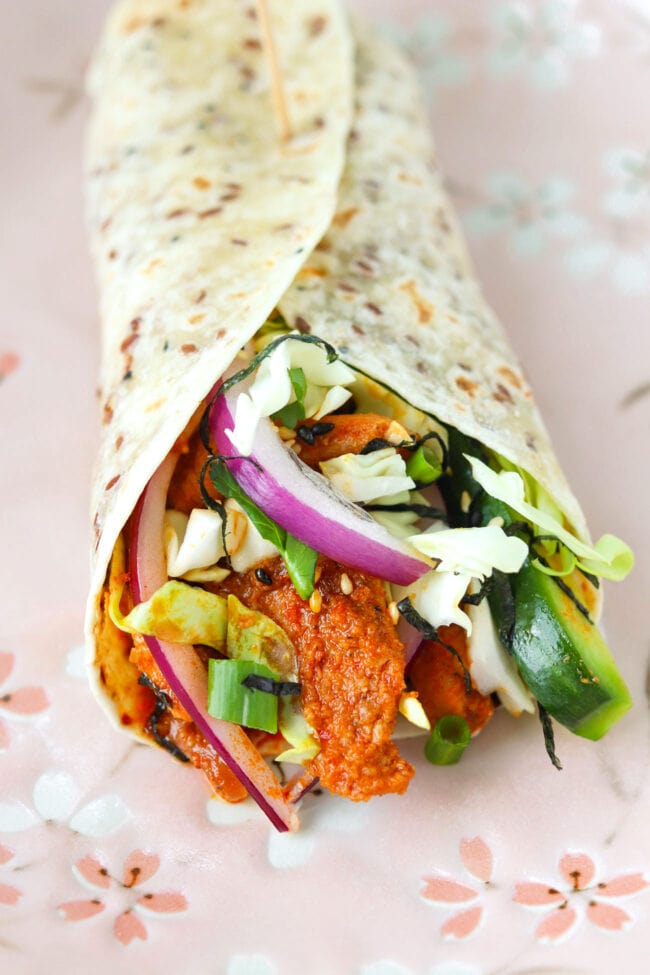
How to Make Korean Chicken Wrap
1. Marinate the chicken. Whisk together all the marinade ingredients in a bowl. Slice the chicken breasts into strips. Add to the marinade and toss to coat. Cover and place in the fridge to marinate for at least 2 hours or overnight for best flavor.
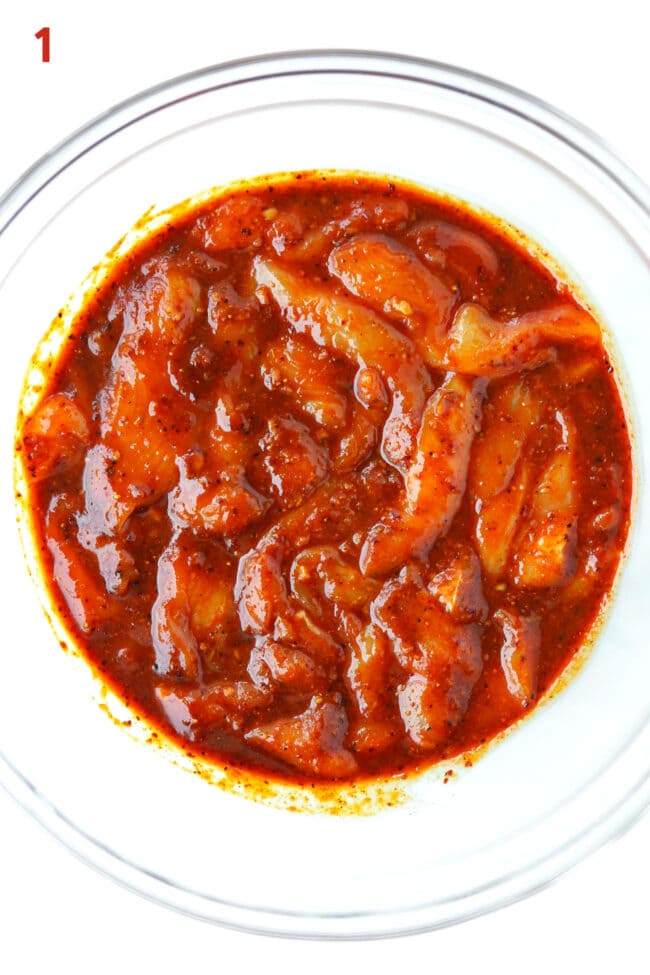
2. Cook the spicy gochujang chicken. Heat some oil in skillet. Add the marinated chicken and all the marinade in the bowl. Sauté for a few minutes until the chicken is almost cooked through. Add sliced red onion and sauté until softened and the chicken is fully cooked.
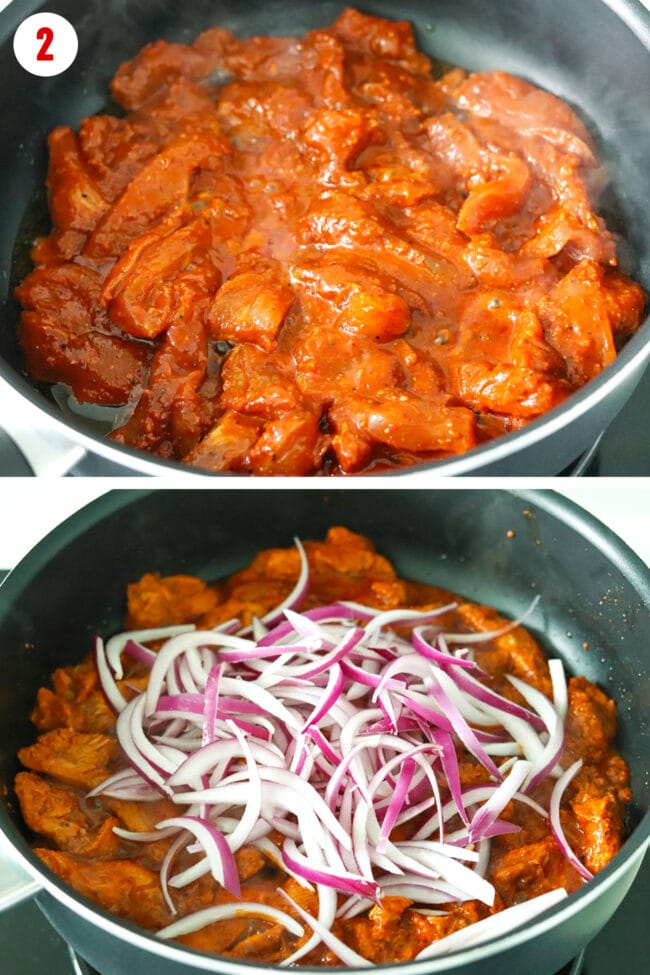
3. Assemble wraps. Warm tortillas as per package instructions in the microwave. Spread mayo on top, then top with the spicy gochujang chicken, shredded cabbage, sliced red onion, and cucumber. Sprinkle with chopped coriander, spring onion, shredded seaweed, and toasted white and black sesame seeds.
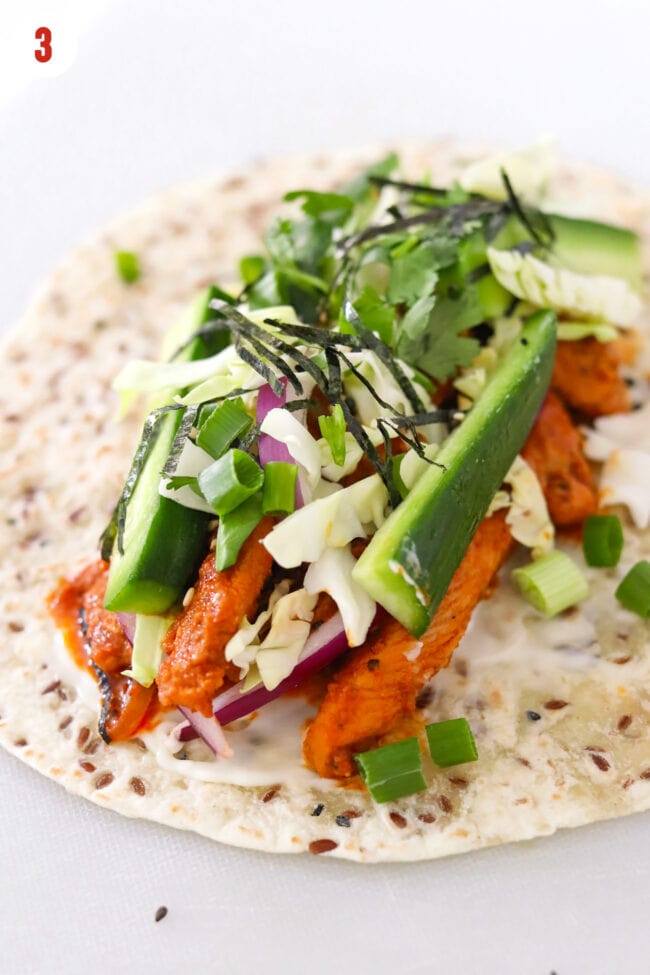
Wrap and enjoy!

Full detailed instructions are in the recipe card below.
Cook’s Tips
- Use a skillet with deep edges to cook the chicken. This will prevent the marinade from splattering all over your stovetop.
- Don’t overstuff the wraps. They’ll be difficult to fold and seal otherwise. It’s also wise to only pile the filling in the center and upper two thirds of the tortilla so that you can fold the bottom over, then the sides to seal.
- Use a toothpick to hold the wrap in place. After folding the bottom and the sides of the tortilla over the filling, pierce the wrap with a toothpick to hold it in place. This will make it easier to eat without the filling and toppings falling out.
- Adjust spice level to taste. Use less gochujang (2 tablespoons instead of 3) to make the chicken milder. You can also use less (or omit) of the gochugaru, ground cayenne, and pure chili oil in the chicken marinade.
- Store leftover chicken in the fridge. Leftover spicy gochujang chicken can be stored in the fridge in a sealed airtight container for 3-4 days. You can either warm the chicken for a few seconds in the microwave before assembling the wraps, or use it cold. It tastes great either way!

FAQs
Gochugaru is a coarse ground chili powder, while gochujang is a Korean chili paste made with fermented soybeans, glutinous rice, red chili pepper flakes, and salt. Spice levels for both vary depending on the brand.
If sealed properly and stored in the fridge, the tub of gochujang can last for up to 2 years. If you don’t use it that often, make sure that the paste color hasn’t changed or dried out before adding to a recipe.
Gochujang can be used in sauces for stir-fries, meat marinades, and in a dipping sauce for Korean fried chicken. Some tasty recipes with gochujang to try are spicy gochujang chicken meatballs, kimchi fried rice, stir-fried kimchi chicken noodles, spicy Korean pork stir-fry, and creamy spicy Korean udon noodles with bulgogi chicken.
Variations
- Make it gluten-free. Use a gluten-free gochujang (such as Wholly gochujang), gluten-free light soy sauce (low sodium preferred), and GF certified mirin and sake. Also, use gluten-free tortillas for the wraps.
- Use sliced pork or beef. Pork collar meat, tenderloin/fillet, or beef flank or skirt steak can be used in place of the chicken. Note that sautéing time to cook pork or beef may vary slightly depending cut used. It will take approximately 4-6 minutes for pork or beef to fully cook, so add the red onion after sautéing the meat for 3 minutes.
- Make it vegetarian: Use a plant-based meat substitute and slice into strips instead of chicken. You only need to marinate for 2-4 hours if using a vegetarian protein alternative.
- For keto friendly diets. Omit the mirin and use a no sugar or low-carb honey or other sweetener for the marinade. Also, use keto friendly tortillas or serve the gochujang chicken with toppings in lettuce wraps instead. Bibb, Boston, little gem, and butter lettuce are hardy and won’t wilt easily – they’re perfect for lettuce wraps!
- Make sandwiches. Instead of wraps, pile the spicy gochujang chicken and toppings into sandwiches using your choice of bread instead!
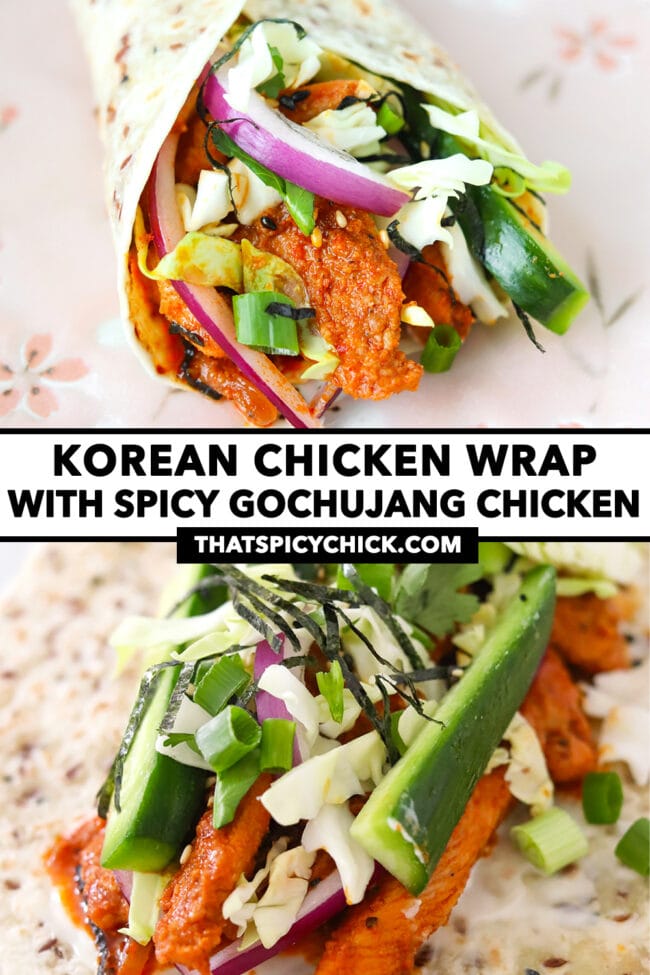
More Korean and Korean-inspired Recipes
- Spicy Gochujang Chicken Meatballs
- Spicy Miso Ramen with Chicken Meatballs
- Kimchi Fried Rice with Pork Belly
- Spicy Korean Pork Stir-fry
- Stir-fried Kimchi Chicken Noodles
- Or browse the entire Korean recipes collection.
MADE THIS RECIPE? If you make this recipe, leave a comment below and let me know how you liked it! Take a photo and tag it with @thatspicychick on Instagram and hashtag it #thatspicychick and I’ll be sure to share your masterpiece!
STAY CONNECTED! You can also follow me on Pinterest, Facebook or Instagram. Sign up for my email list to get my latest recipe in your inbox weekly!
PrintKorean Chicken Wrap
Spicy gochujang chicken strips are piled onto tortillas and complimented with mayo, shredded cabbage, red onion, cucumber, coriander, spring onion, shredded seaweed and toasted sesame seeds in this easy meal prep friendly Korean Chicken Wrap!
- Prep Time: 20
- Cook Time: 8
- Total Time: 28 minutes
- Yield: 5 1x
- Category: Lunch
- Method: Sauté
- Cuisine: Korean-inspired
Ingredients
For the Spicy Gochujang Chicken:
- 3 TBLS Gochujang (Korean chili pepper paste – note 1)
- ½ TBLS Gochugaru (course ground Korean chili powder flakes – note 1), to taste
- 2 TBLS Ginger Garlic Paste (note 2)
- 2 TBLS Low Sodium Light Soy Sauce
- 1 TBLS Mirin (Japanese sweet rice wine – note 3)
- ½ TBLS Korean Sake (optional – note 4)
- 1 TBLS Honey
- ¾ TSP Kosher Salt (note 5)
- ½ – 1 TSP freshly cracked Black Pepper, to taste
- ½ – 1 TSP ground Cayenne (optional), to taste
- 1 TBLS Sesame Oil
- 1 TSP Pure Chili Oil (optional – without seeds/flakes)
- 400 grams / 14 ounces Chicken Breasts, boneless, skinless – cleaned and pat-dried, sliced into ½-inch wide strips
- 1.5 TBLS Canola Oil (or other neutral flavored cooking oil), for cooking
- ¾ small Red Onion – thinly sliced
For the Wraps:
- 4 – 5 Tortillas (plain, herbs, four seeds, whole wheat, etc. – your choice)
- 3 – 4 TBLS Mayonnaise, as needed
- ¾ cup shredded Cabbage (regular green or red cabbage)
- ¼ small Red Onion – thinly sliced
- 1 small Cucumber – sliced into 1.5-inch long and ½-inch wide strips
- 2–3 TBLS Coriander (Cilantro) – finely chopped
- 1 Spring Onion (Scallion/Green Onion) – finely chopped
- 2 – 3TBLS finely shredded Roasted Seaweed (kizami nori – optional – note 6)
- 1 TBLS Toasted White Sesame Seeds
- 1 TBLS Toasted Black Sesame Seeds
Instructions
- Marinate the spicy gochujang chicken: In a medium-sized mixing bowl, combine the gochujang, gochugaru, ginger garlic paste, low sodium light soy sauce, mirin, Korean sake, honey, kosher salt, black pepper, ground cayenne, sesame oil, and pure chili oil. Mix with a spoon until smooth and combined well. Clean and pat-dry the chicken breasts and slice into ½-inch wide strips. Transfer to the marinade bowl and mix well to coat. Cover with cling wrap and place in the fridge to marinate for 2-4 hours, or overnight for best flavor.
- Cook the chicken: Take out the bowl with the marinated chicken from the fridge 30 minutes before you plan to cook to take the chill off. Heat canola oil in a medium-sized skillet over medium-high heat. Once hot, add the chicken and all of the marinade in the bowl to the skillet. Sauté for 5 minutes, then add the sliced red onion and sauté for another 2-3 minutes until softened and the chicken has cooked through. (You can check for doneness by cutting a piece to make sure it’s white inside). Remove the pan from the heat.
- Assemble wraps: Warm the tortillas as per package instructions in the microwave. Spread mayonnaise on each tortilla. In the center and upper two thirds of the tortillas, add some of the spicy gochujang chicken and top with shredded cabbage, sliced red onion, and cucumber. Sprinkle with chopped coriander, spring onion, shredded seaweed, and toasted white and black sesame seeds. Fold the wrap over the bottom. Then fold in the left side of the wrap, followed by the right side to seal. Poke a toothpick through the center to hold the wrap and filling in place. Fold and seal the remaining wraps. Then serve and enjoy!
Notes
- Gochujang and gochugaru. Gochujang is a Korean chili paste made with fermented soybeans, glutinous rice, red chili pepper flakes, and salt. Gochugaru is a Korean coarse ground chili powder. Spice levels for both vary depending on the brand. Gochujang can be found in the Asian aisle of most mainstream supermarkets today and in Asian or Korean supermarkets. Gochugaru is available in Asian or Korean supermarkets and online.
- Ginger Garlic Paste. This in a paste that’s commonly used in Indian cooking instead of fresh garlic and ginger. It has an ultra-smooth and fine texture and is great for marinades. Find it in an Indian grocery store or purchase a jar online. Alternatively, use 1 tablespoon each of smashed or finely minced fresh ginger and garlic instead.
- Mirin. This is a Japanese sweet rice wine that is often used as a sweetener in Japanese cuisine. Korean cuisine has a counterpart, mirim, which is identical in flavor and taste. Look for it in an Asian supermarket. If you prefer not to cook with alcohol, substitute with more honey instead.
- Korean Sake. This is a Korean cooking wine used to help tenderize and bring out the flavors in the meat. You can use Japanese sake instead too. Omit if you prefer not to cook with alcohol.
- Kosher Salt: Use slightly less than half the amount indicated if using iodized sea salt.
- Finely shredded Seaweed (nori): You can find store-bought roasted shredded seaweed in packs in packs at Japanese and Asian supermarkets. It has a savory umami flavor and crisp texture, and commonly used to top rice, noodles, vegetables, and meat and seafood bowls in Japanese and Korean cuisine. Feel free to leave it out if you don’t have it on hand.
- Adjust spice level to taste. To make the chicken milder, use less gochujang (2 tablespoons instead of 3). You can also use less (or omit) of the gochugaru, ground cayenne, and pure chili oil in the chicken marinade.
- Leftovers and storage. Leftover spicy gochujang chicken can be stored in the fridge in a sealed airtight container for 3-4 days. You can either warm the chicken for a few seconds in the microwave before assembling the wraps, or use it cold. It tastes great either way!
- Recipe total time does not account for marinating the spicy gochujang chicken.
- See ‘Variations’ section to customize these wraps.
Nutrition
- Serving Size: 1 wrap
- Calories: 468
- Sugar: 14.1g
- Sodium: 1394.4mg
- Fat: 22g
- Saturated Fat: 3.2g
- Unsaturated Fat: 17.3g
- Trans Fat: 0g
- Carbohydrates: 43.6g
- Fiber: 2.9g
- Protein: 24.4g
- Cholesterol: 61.9mg
This post may contain affiliate links. We are a part of the Amazon Services LLC Associates Program, an affiliate advertising program designed to provide a means for us to earn a small commission (at no extra cost to you) by linking to Amazon.com and affiliated sites. The nutritional information provided is approximate and can vary based on several factors. It should only be used as a general guideline. For more information, please see our Disclosure.

